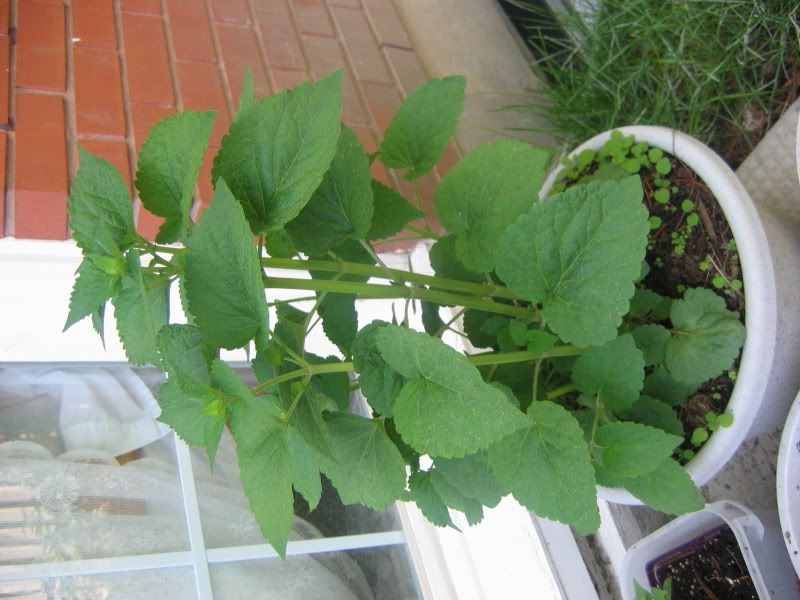Licorice tea, anyone?
 This poor plant has been schlepped around from one place to another, but it doesn't seem to be complaining. I originally grew it from seed a few years ago, then moved it to our new place last year. It got too leggy where I had it in mostly shade (it doesn't mind partial shade, but enough is enough!), so I moved it to one of the few spots in the backyard that gets significant sun. But that was prime real estate and a variegated weigela signed a long-term lease this spring so the anise hyssop was evicted.
This poor plant has been schlepped around from one place to another, but it doesn't seem to be complaining. I originally grew it from seed a few years ago, then moved it to our new place last year. It got too leggy where I had it in mostly shade (it doesn't mind partial shade, but enough is enough!), so I moved it to one of the few spots in the backyard that gets significant sun. But that was prime real estate and a variegated weigela signed a long-term lease this spring so the anise hyssop was evicted.
Now, anise hyssop - at least the species - is not the most beautiful of plants but there are a couple of reasons it was hard to part with, so I moved it to a pot. First, it turns into a small bush and provides some welcome mass in a new garden where almost everything is spindly. By its sheer mass, it was a focal point in the garden. Secondly, it's a highly fragrant plant that smells beautifully of licorice when you ruffle the leaves and makes a wonderful tea. Thirdly (yes, I know I said a couple, but I'm cheating) it is a great favourite of bees and I find it amusing to watch them working the spikes of purple flowers.
Unlike some other members of the mint family, it doesn't spread by runners. As you can see by the surface of the soil, it self-seeds rather generously but the seedlings don't grow very vigorously unless they're in an excellent position, so they're very easy to control.
All in all, I'd say that Agastache foeniculum is more at home in a herb garden than an ornamental border. The cultivar 'Golden Jubilee' with its yellow leaves, or the hybrid 'Blue Fortune', which looks very pretty in photos, could be a different matter.


7 comments:
I am a big fan of anise hyssop too Janet ! .. I couldn't have a garden without one .. and I also have the "golden" version that I put in last year .. it came back with no problem which surprised me !
Good job on the blog Janet !
Joy : )
Hi Janet,
I appreciate your personal comments interspersed with cultural information. Looking forward to a long-running ever-growing resource for fellow gardeners!
Janet, how do you make this tea? I have the plant too, but need the space. It will be evicted soon if I can't find a use for some of it! I found the flowers to be not worth it, and I have lots of other things that the bees and butterflies like that have nice flowers too.
Does the tea have medicinal value? Like a tummy soother?
Linnea, I've been told that it is supposed to be good for arthritis. I've never drunk enough of it to find out if it works.
I just stuff a mug with clean leaves, fill with water and nuke it. As often as not, I throw every kind of leaf I've got suitable for herb teas in too. Never quite the same, always good.
I'm going to go whack the plant back now to keep it shorter and dry the leaves, after which they'll be crumbled and used like any loose tea.
Hope this helps.
I believe the blue flowers also have medicinal value. Is this true? What is it good for and how can it be used? Is it poisonous in large quantities?
Terry
Terry, I don't know of any medicinal value of the flowers. That doesn't mean there isn't any, because I have no special expertise in this area. As far as I know, there is no poisonous effect to large quantities. Of course, mega quantities of almost anything - even water - are unhealthy because of the unbalances created.
If I have the good fortune to have a larger garden in the future, I will definitely grow anise hyssop in larger quantities and start drinking the tea on a regular basis.
Sorry I can't help you more than this.
An insightful post on licorice tea.
I found this website useful for Herb Gardening tips http://www.herbgardeningtoday.com. I think you guys will find it interesting too.
Thanks,
Mark - Home herb garden
Post a Comment